While waiting to get into the NVIDIA CES 2013 Special Event as well as myself waiting to watch the live webcast, get ready for some huge announcements from NVIDIA. What could we see?

I'm sure NVIDIA will take the stage and hopefully show off some next-gen Tegra 4 SoC gear, or maybe a tease of an upcoming new product we haven't heard of yet? Keep coming back as we're going to be reporting this live as it happens.
And it's starting! CEO and co-founder Jen-Hsun Huang has just taken the stage. Huang is talking about the iPod being a huge change for technology, talks about the Amazon Kindle which allowed you to download a book in just a minute without being connected to a PC, completely untethered. The cloud is being pushed by the NVIDIA CEO, talking about streaming video, movies and then pushing anything to a device with a smart processor inside.
Huang continues saying in the course of just 10 years, "everything has changed". Connected to PCs, unconnected with anything - where you're able to enjoy everything wherever you are. He says that the ironic part of it has changed, and hasn't included the single largest part of the entertainment industry - video games, which is the largest industry today - can't benefit from this technology - untethered.
Huang says the question is, what is it that we have to do as an industry and what technology has to be made to make this happen - to make this "giant step forward in how we enjoy video games".
The NVIDIA CEO says that the PC industry is thriving - and talks about Call of Duty: Black Ops II making half a billion dollars in 24 hours, and notes that no movie in Hollywood industry has reached this achievement - within two weeks, it smashed one billion. $13 billion in revenues are made on MMOs each year, compared to NRL which makes just $9 billion in a year.
He notes that the PC is open, any developer can create games to it, it's completely open to user-based development, free-to-play and says that free-to-play is a huge segment of the market and one of the biggest in growth right now. Gamers are innovating, gamers are publishing themselves, creating their own content and software in these free-to-play environments. These users can make thousands of dollars per year from user-generated content, which PC is the only gaming platform it is capable of thriving on right now.
Comparing consoles to the PC, saying that the Xbox 360 only sports 240 GFLOPS - compared to a Core i7 with a GEFORCE GTX 680 which is 15x as powerful as the current-generation consoles. The install base has configurations has shifted over the years, citing that thousands of configurations across the world with different PCs. This is where configurations within the game itself come into play. Draw distance, graphic detail, anistrophic filtering, anti-aliasing and countless other video settings let gamers with different hardware enjoy the game on their hardware.
SSAO is also talked about, with Huang saying that all of these technologies are "so confusing" and saying how can a gamer know about these technologies. How can they possibly find the best settings? Huang talks back to 2007, with the G80 card, the GeForce 8800 series, where he took it back to his son Spencer, and while his son was installing it - he comes back and says "how does it look" - he asks him to change the settings and his son replies "I just want to play the game". He continues, "why can't you guys just set it up for us"?
He replies, it's technical - it's not possible to set it up automatically. He knew his son was right - and that it should be done automatically. Huang says that NVIDIA undertook a huge project and tried to collate all settings in games, and hardware configurations and through a bunch of man hours, they came up with a technology that allows you to set the visual settings within a game - and have them worked out automatically.
All of this is done in the cloud, and pushed to your PC through some software. We're about to hear about it - how incredibly exciting! GeForce Experience is here!
GeForce Experience has had years of man hours pumped into it - NVIDIA have had "expert gamers" play their games with settings used, and these settings are pushed into the cloud - which is done for each and every game. GFE, which Huang calls it, "magically inserts" the settings into your game - comes up in "the most beautiful and the most playable settings that your PC allows".
NVIDIA choose to push the most graphics intensive game out there - Call of Duty: Black Ops II - and I'm being sarcastic here. Wow, I can't believe NVIDIA have done this. Well, they're showing it on a GEFORCE GTX 680 at 1280x720 - because you know, that's how you roll with a $500+ GPU.
There is a difference in the rendering of the engine - it looks better, with two soldiers to the left who are still blurry before and after GFE, but Huang pushes it as if the graphics just jumped into next-gen consoles. GFE is pushing the "simplicity of a gaming console" but with the power of a PC.
Cloud computing is being pushed - as expected, where a single cloud can serve every user as a service, would revolutionize computing. This service [cloud computing] is used across the entire board of technology. Huang cites Hotmail as his first experience of cloud computing and use of the cloud personally.
Broadband speeds are a huge part of this, cites Huang, where the accessibility of cloud computing becomes even bigger than usual - citing that this is the "best way of using computers". Continuing that the software most people use is often in the cloud. Cloud computing architecture has benefitted most other industries, but this technology and incredible revolution in computing has "left video games behind". Huang says that video games are a unique medium of its kind.
Huang states that H.264 is used to push video to users, but with video games the entire video game world is being synthethized where every frame is being recomputed. The lighting, animation, physics, AI, gameplay, etc are all being computed in real-time for every single frame - so 3D graphics, Huang says is a very unique media.
NVIDIA had to create a system that was dedicated and optimized for high-quality and high-density video game streaming. It was required to deliver it in a high-quality way. A software stack had to be created as there is not one that exists that can serve out this type of data to give users a unique experience, in high quality. NVIDIA had to create software that is in all gamers' PCs that can handle the streamed data in low-latency, but in a high-quality way - NVIDIA have taken five years to reach this point.
NVIDIA's first fully integrated product - the NVIDIA GRID.
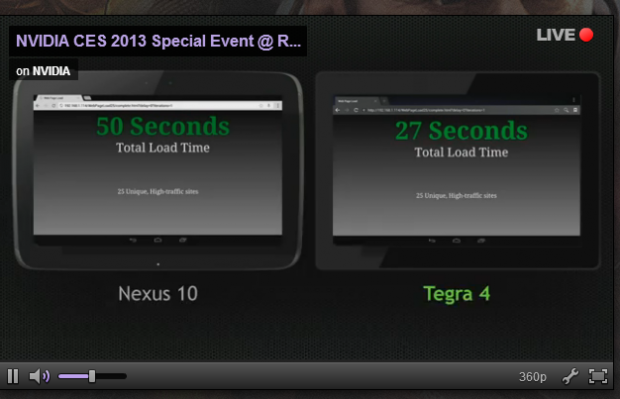
Each server is packed full of GPUs - with each GPU capable of running concurrently, handling many users at the same time. 24 concurrent users on one computing node - your PC currently supports one, where NVIDIA will be able to support 24 users that will occupy the same amount of physical space of a current desktop PC.
240 NVIDIA GPUs - 200 TFLOPS, around 720 x Xbox 360s... 720 x Xbox 360's would take 10 of these NVIDIA GRID racks. It would consume around 5 times as much power. I don't know why NVIDIA are comparing everything to the Xbox 360 - but here we are, constantly referring to an ageing console.
NVIDIA are now showing an LG TV, which is pushed to the NVIDIA GRID - a wired controller is being used, because that's how NVIDIA roll.
NVIDIA are showing off LG's latest smart TV, taking the GRID receiver client - LG have ported it to their TV and all that is required is an ethernet connection. Everything else is streaming, all without wires - except for that awesome wired controller.
An ASUS Transformer Prime, which is Tegra 3-powered, is now teased running NVIDIA GRID which is a client app installed.
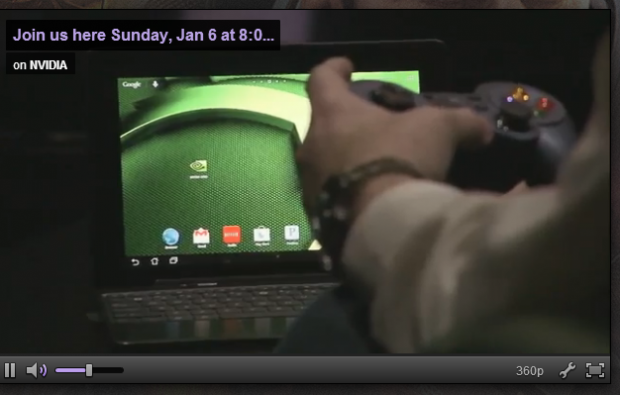
The client is launched and "magically, amazingly" the same UI is displayed on the LG smart TV. NVIDIA push that on the road, it's great to have this technology. They load the saved game that was saved online in the NVIDIA GRID - on the Transformer Prime. Welcome to Steam, everyone.
So, NVIDIA has effectively shown a slightly modified version of Steam - but as a service available on devices. NVIDIA GRID is their first fully integrated system product, which is sold to MSOs and anybody who would want to host or stream cloud-based games. Some partners:
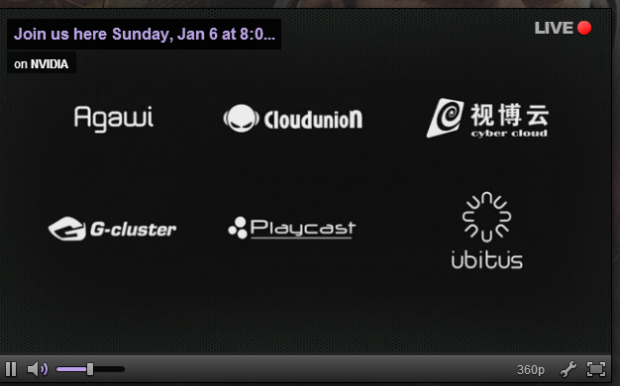
Cloud gaming is an "industry that is coming to fruition" states Huang.
NVIDIA had to architect a brand new GPU, a new system for NVIDIA GRID for how complex it is over the cloud - as well as the client software in the wild. All of these are the "first of its kind" inventions, taking over five years. Huang thanks their engineers - who would've done all the hard work.
Tegra 4 has been announced! 72 GPU cores, 4 x A15-based cores, 4G LTE support!
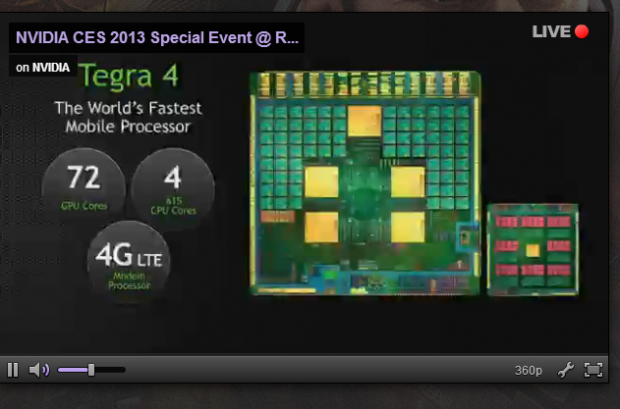
NVIDIA's first 4G LTE modem is included in their Tegra 4 SoC - with Huang asking "how fast does fast have to be?". In order to show us, they're going to show us the fastest Android-based tablet in the world today - and put it to a foot race against a Tegra 4-based tablet.
The first tablet, Samsung-built Nexus 10 and another with a Tegra 4 chip. Web pages load "snappier" on Tegra 4 - but here we have with some tests - oh boy!
Both tablets are pulling the pages over the router, so Internet congestion isn't a problem. The Tegra 4 pulls them down at insane speeds compared to the Nexus 10. Sites used on a daily basis by most users - but the Tegra 4-based tablet takes around 27 seconds to load 25 unique webpages... on the Nexus 10 it took much longer - at 50 seconds.
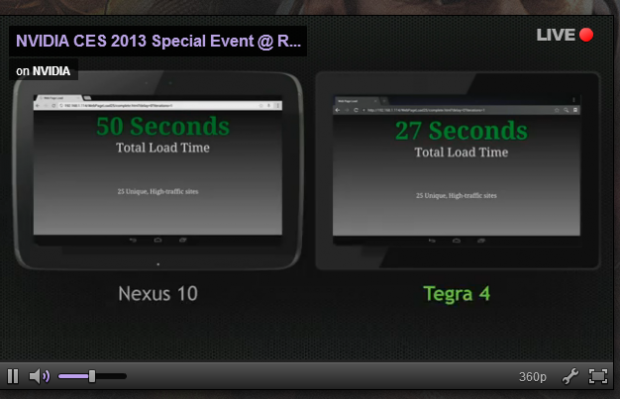
Impressive work by the Tegra 4 in real-world stuff like loading web pages. Tegra 4 loads up a website in around one second - compared to the best Android tablet in the world right now, the Nexus 10 - which would take two seconds. NVIDIA pushes that the Tegra 4 can load a website twice as fast, because you know - one second is so long.
Huang is pushing HDR shots, as the phone is the camera that most people use right now. I've never seen HDR until now, and I'm so surprised at this new fan dangled technology. NVIDIA are pushing it like it's a new technology - which, I thought we'd see a 30 second speech on, but Huang is pacing that stage talking about HDR like it's next-gen tech.
Tegra 4 takes two shots at once, one shot with high exposure, one with low. The shot gets dumped into the "computational photography engine" and uses all of the tech in the Tegra 4 to do the necessary work so quickly that it effectively gives you HDR at the end of the shot.
BAM BAM.
Tegra 4 takes two shots, which is ten times faster than the old NVIDIA "old shot" HDR. It is "basically a one-shot HDR".
Holly comes out, and her favorite video games are Skyrim, and "everything Star Wars" and "blah, blah, blah". Never heard of that, but maybe I'll check it out on NVIDIA GRID. Now Huang is going to have some shots with Holly - with a Tegra 4-based device to show off their HDR capabilities - a prototype camera, with a prototype device.
The device is a Windows 8-based tablet, which is something surprising....
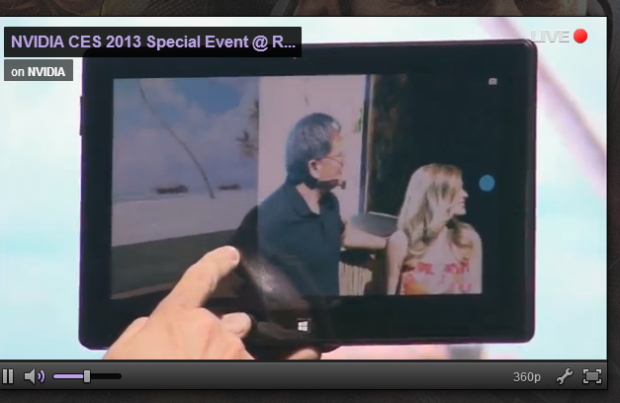
Android UI by the looks of things - I wonder what is going on here?
Huang says that these cameras with "super computers" will do amazing things in the future.
Video games are about to get talked about, oh wait, still on Tegra here. Tegra Zone is talked about, where NVIDIA can make them available to gamers on compatible tablets. All games are optimized, tested rigorously - as their engineers have worked with the developers to make sure they work amazingly well on Tegra devices.
A new never-before-seen game gets shown off, which looks like a new first-person shooter. It is reminding me of the original Quake with its huge enemy - Shambler, anyone? And Killzone on the PlayStation. Dead Trigger 2 is the game.
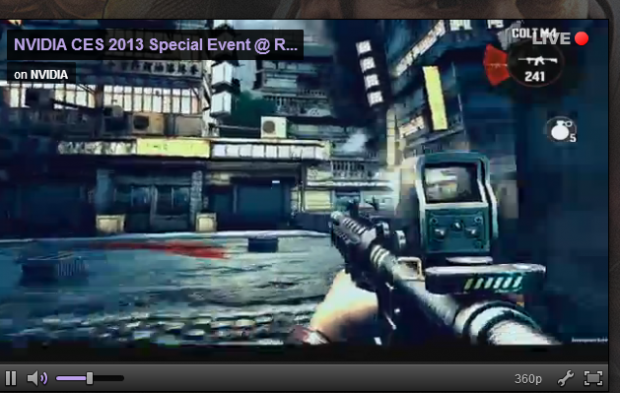
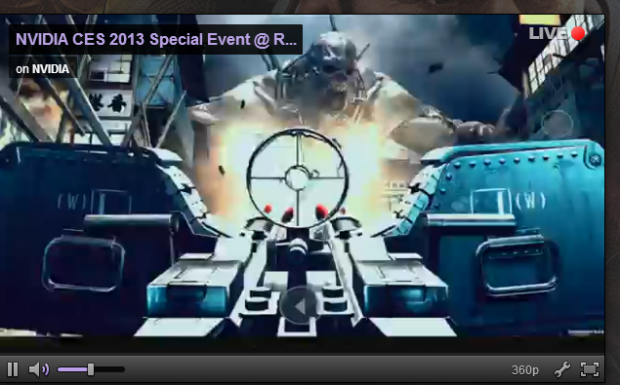
NVIDIA will be sampling their first modem later this month, the I500 - sports 8 modem processors on-board which are programmable.
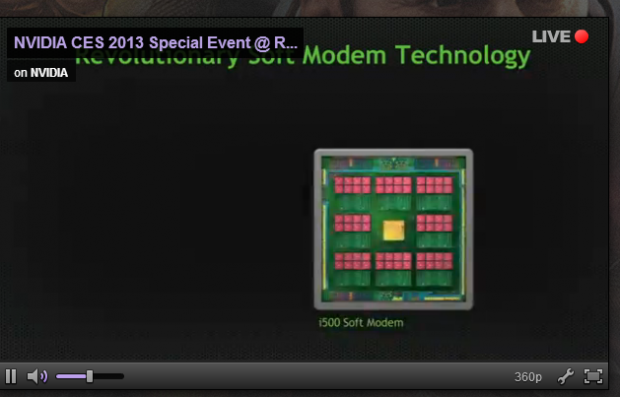
1.2 trillion operations per second is all coming from this little modem - a tiny chip can do 1.2 sustained TFLOPS. NVIDIA GRID is 200 TFLOPS, so that is quite crazy for a tiny chip. A tiny programmable processor.
NVIDIA can program their modem chip as it is programmable, so as technology improves, so will the modem tech inside of Tegra 4. Huang reiterates 72 GPU cores, 4 Cortex A15 cores and 4G LTE capabilities.
Huang now wants to talk about "something new"...
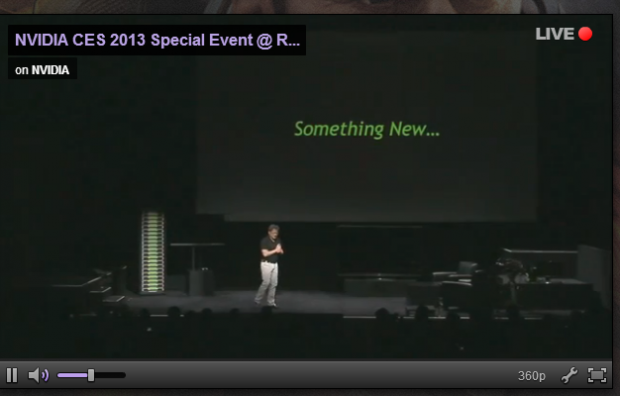
Huang says that gamers play games on so many devices, smartphones, tablets, PCs - next-gen gamers play everywhere they can, on anything they can. Just like music is listened to on many devices. Two ecosystems are growing fast - the Windows platform, and Android. The fastest OS growth in the "history of mankind".
Apple? Ha.
NVIDIA's feeling is that the PC games and Android games will continue to grow - but NVIDIA have a way to help gamers enjoy games even better. Huang states that they're really the only company in the world with the technology and dedication to build devices that will allow gamers to enjoy games in a "very different way".
NVIDIA said "what if" they could build a device - and now we're going to see it....
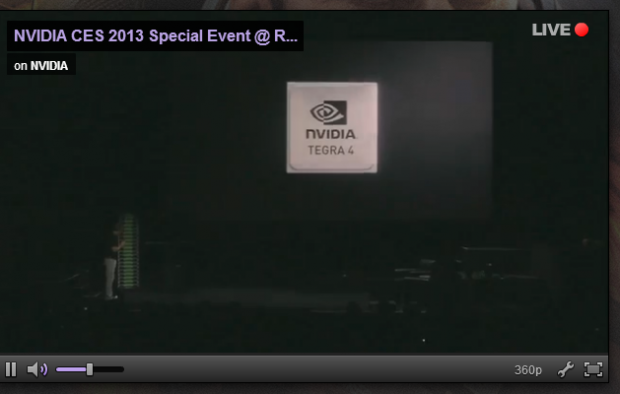
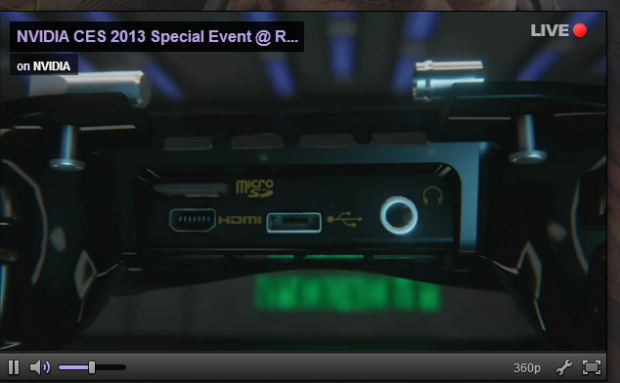
What is it? A console? A tablet? Wait...
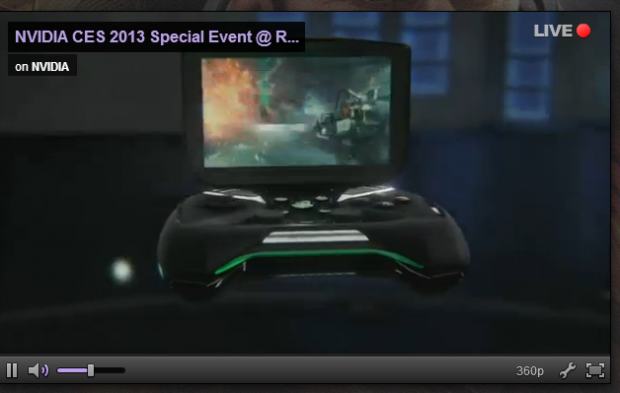
Project Shield. Tegra 4-based tablet
- The world's first Tegra 4 processor.
- Extended 38 watt hours - 5-10 hours of gameplay
- High-def video - around 24 hours of high-def video playback
- Audio system - tuned port, custom bass reflex (world's first custom bass reflex system)
- Game controller - "console-grade"
- Pure Android - no NVIDIA user interface on top
- Full connectivity - HDMI, micro-USB, microSD slot, 3.5mm audio jack
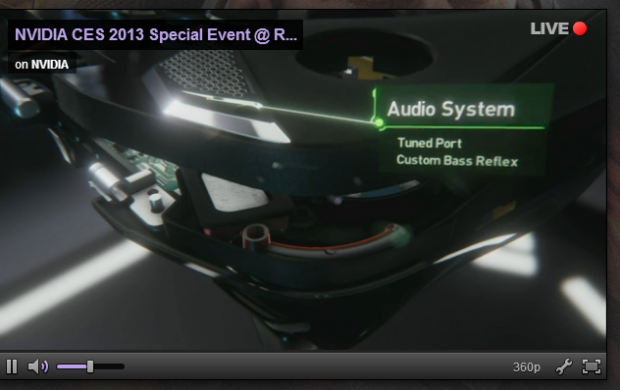
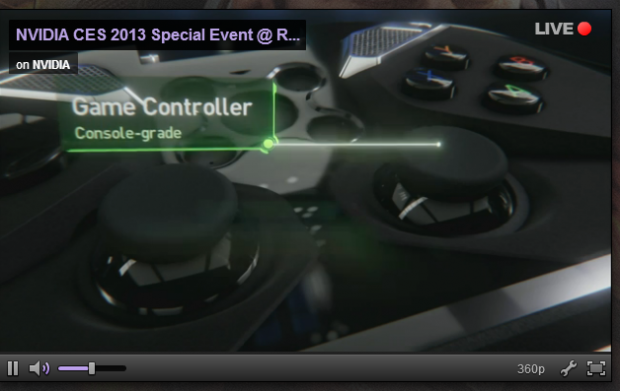
The above shots were rendered in real-time with Unreal Engine 4. Customizable tag - allows you to take it off, replace it with a new backing.
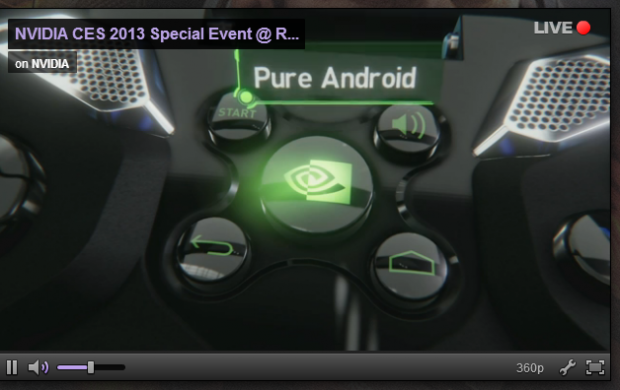
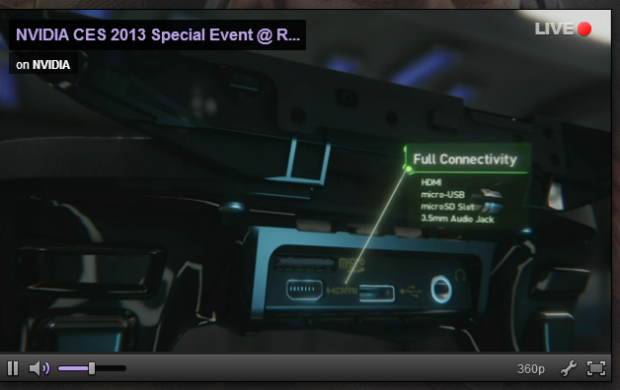
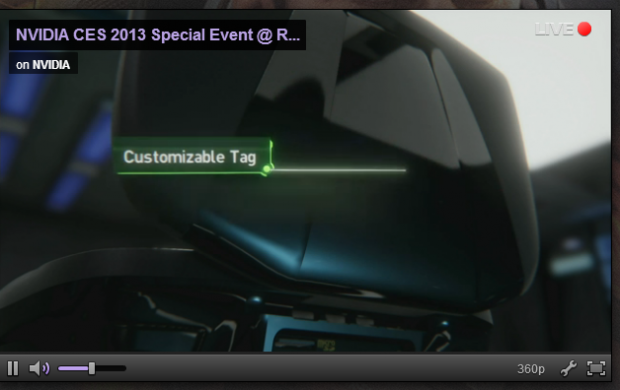
Pure Android - no NVIDIA user interface at all. Amazing - thank you, NVIDIA.
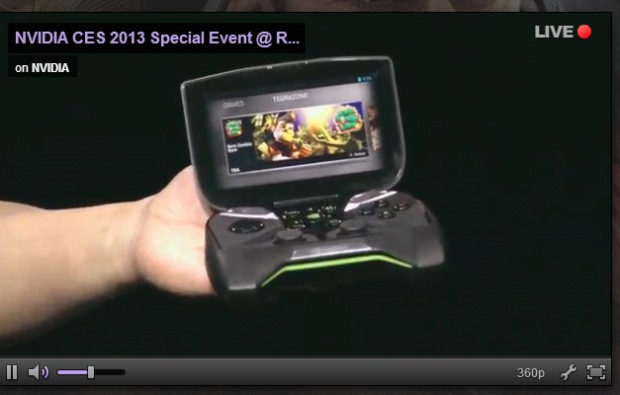
NVIDIA's Shield looks small, a little bigger than a console controller - Huang has said "it's the same size as any controller". All content, all games just "show up" on your Shield gaming device. Again, some wires are used - it's 2013, but oh well. Huang begins to hook up his device to his LG smart TV.
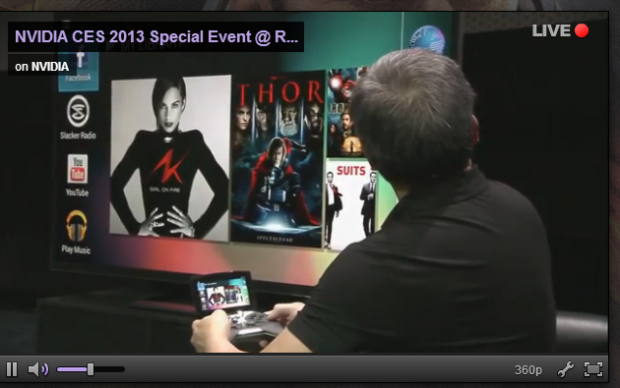
We're seeing some music being played, some photos browsed - everything looks quite smooth - this is Android after all. Huang pulls up Thor - which suits the name well being "Shield". I love the small things NVIDIA are doing here with the name. We just need Robert Downey Jr. to step out onto the stage.
Huang checks Facebook, says "haha, that's pretty good". Huang now does something that is the "first time ever" - a 4K video from a mobile device. OH YEAH. Yes - we're now seeing some 4K content pumped from a mobile device, NVIDIA - you have impressed.
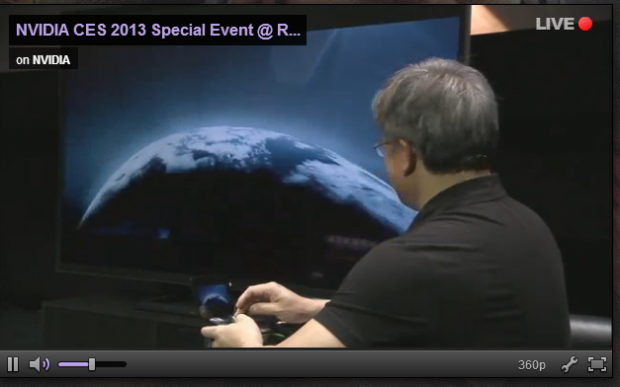
So we're looking at this thing demolishing a current-gen console - pushing out a 4K display from Shield to a TV.
Huang teases some games on Shield, says that the device is connected to the Tegra Zone - optimized for games, playing movies, and more. It can also do multiplayer games, duh.
Huang brings some of the dudes behind Hawken onto the stage - so now my interest has been pumped up.
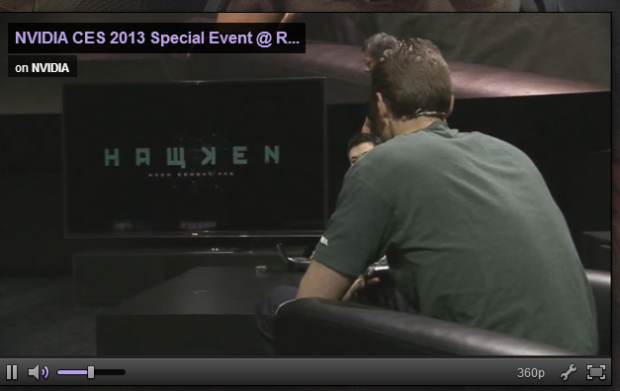
Hawken gets shown, loading up in just seconds - it runs quite well, looks like it is well over 30 fps. The graphics look damn impressive (from the live stream) for a mobile device, that's for sure. Hawken is powered by Unreal Engine 3.0.
Huang now talks about the PC being the world's most powerful controller and TV play on the PC. Looks like we're about to be teased by some Valve stuff with Big Picture - which I loved, here. Huang states 54 million users on Steam, 2000+ games, 70% of digital distribution of PC games comes through Steam.
NVIDIA are now showing everyone something that is possible thanks to all the technology shown off today. Huang talks about streaming from PCs - with a GeForce GTX inside, would connect through Shield. NVIDIA are experiencing technical difficulties showing it off, unfortunately - loading it up two times and failing. Third time attempted and it seems like it's down.
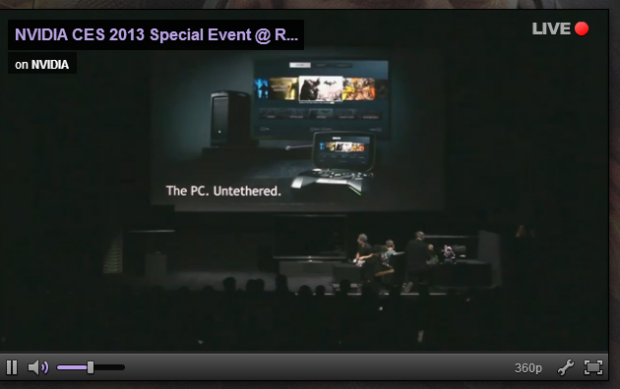
Huang seems calm - but I'm sure he's going to fire 30 people when the curtains fall.
And it's now working!
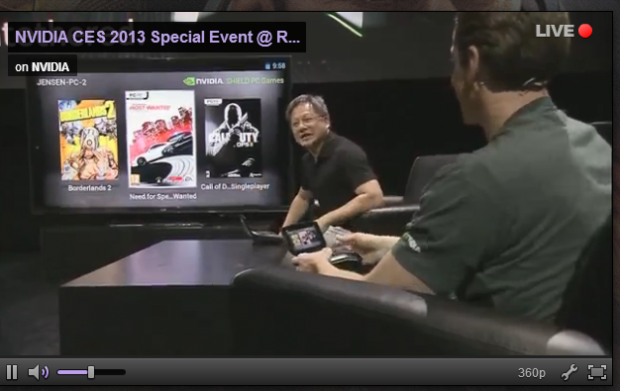
They load up Need for Speed: Most Wanted running on a GEFORCE GTX 680 - with a connection through GFE streaming it to Shield. It loads surprisingly fast considering the amount of work that is going on. The PC streams everything to your Shield device, while your PC pumps away with the game.
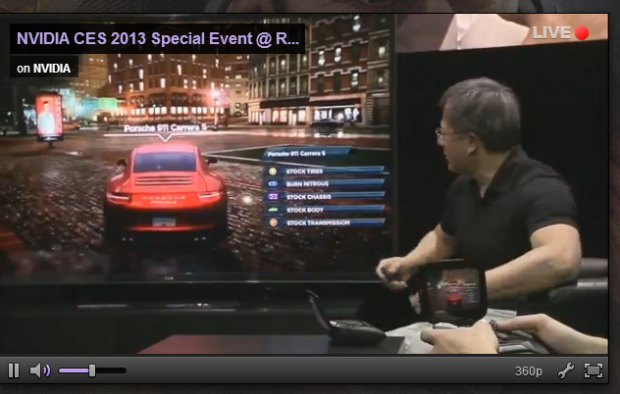
Graphics pumped from the GTX 680-based system and being enjoyed on Shield - which is a feat in itself. Huang explains Shield's controller commands are sending them to the PC, the PC computes and renders the scene and streams it to the Ethernet connection on Shield - at home, this will work on wireless.
NVIDIA are now showing off Assassin's Creed III - Huang doesn't know what it is about - and that scares me. It's one of the biggest games out, and considering NVIDIA fully support the game, that comes as a shock to me.
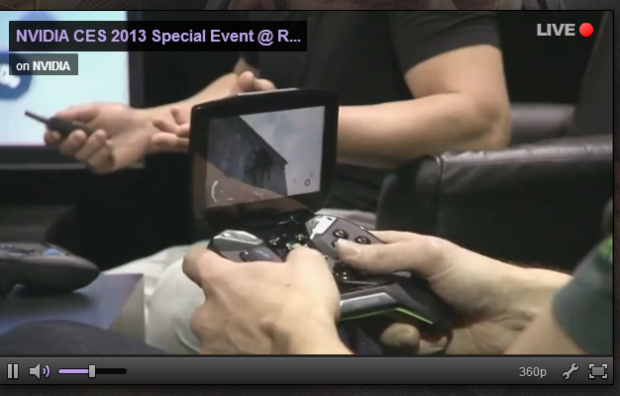
NVIDIA then show off Steam in Big Picture mode - and it "just works".
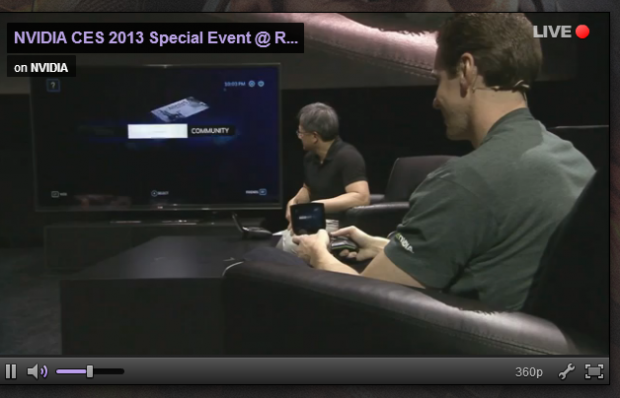
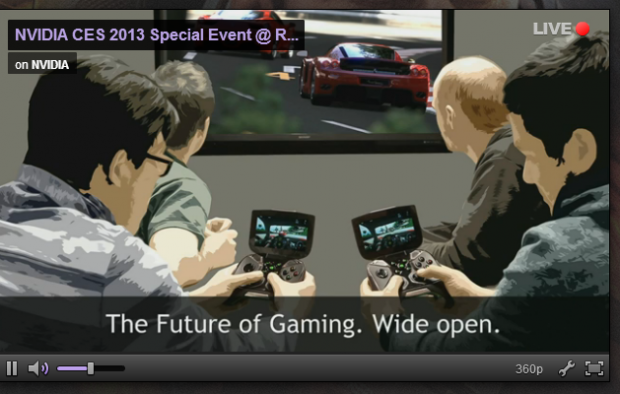
NVIDIA says the consumer electronics industry has radically changed over the last decade, how devices connect differently thanks to the cloud now. NVIDIA wanted to, over the last five years, create the pieces required to do the same for video games.
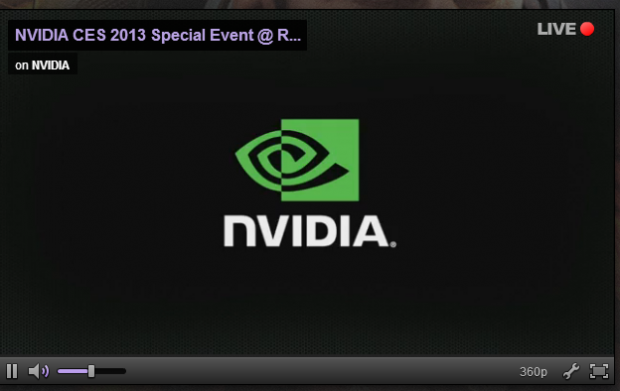
And that's the wrap on NVIDIA's CES 2013 Special Event - what did you think? What did you like the most? Tegra 4? Shield? NVIDIA GRID? Or all of it? Did you expect more?

